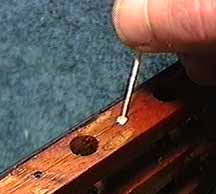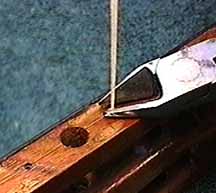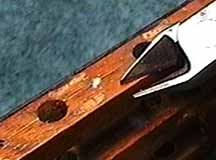Page 2 of 2
I know it's almost redundant, but here's an even faster method
of doing the same thing. If you have flush cutting pliers like these, or any reasonable
facsimile such as a nail clipper, you're in business. A single edge razor blade works
well, too, but requires a little more care.
Just take a toothpick and put a glob of glue on the end:

Stick the pick in the hole:

Snip it off:

That's it!

Too easy? Then how about some cautions?
1. It's important not to fill the hole completely with a giant
piece of toothpick lumber. If you do, let the glue dry overnight. Then you can drill
a new pilot hole and reinstall the screw. Otherwise, you could split delicate wood
parts or break off the screw because it's going in too tight. I usually try to fill
the hole only about 1/2 its diameter. Use flat toothpicks for safety, unless the
hole is a real mess.
2. You can use just about any kind of glue. BUT, you have to be careful not
to damage surrounding finish. Therefore, it's a good idea to use only water-soluble
wood glue (white glue, carpenter glue, etc.) If you use superglue or other strong
solvent-based glue you have to be very careful! Too careful, really, since these
glues have no advantages in this repair. If you smear water-base glue on the finished
surface you can just wipe it of with a wet paper towel.
3. Dealing with a submerged, broken screw is a job for an experienced woodworker.
Trying to "drill it out" can cause an accidents and a real mess. . .
1
2
Back to Index Page